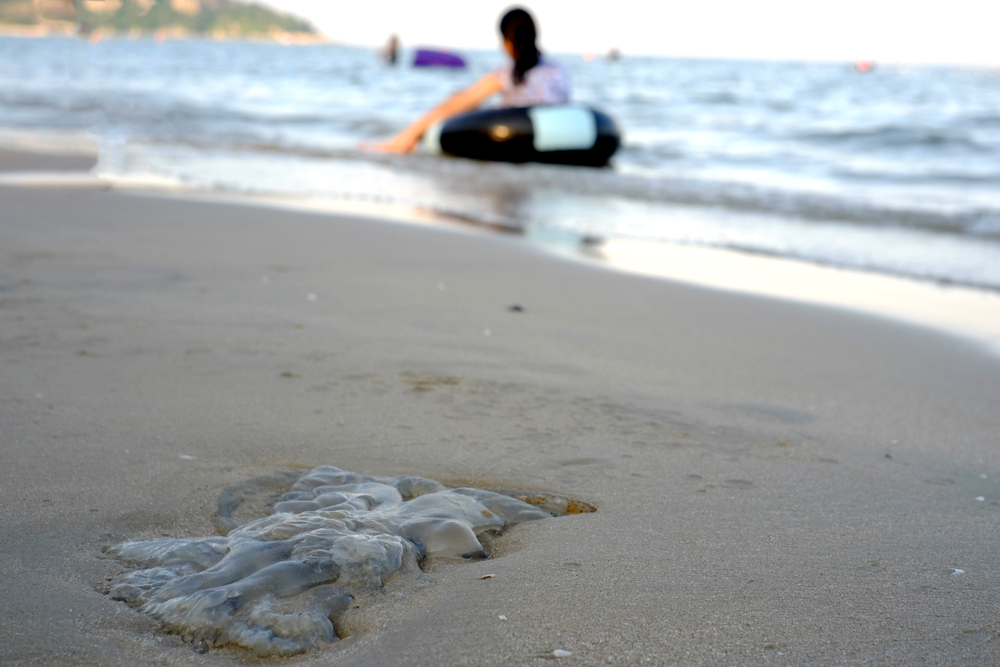- Itchy, red bumps characterize this rash for which treatment is often unnecessary.
- Research shows outbreaks in the coastal region of the United States occur intermittently between March and August, but peak from April through early July. In the Caribbean, jellyfish breed throughout the summer, peaking in May.
- A few key tips can help reduce the risk and minimize symptoms.
What are sea lice?
The name alone is a source of worry, conjuring up exotic images of water-borne parasites and memories of having one’s hair quarantined at school.
In fact, “lice” is a misnomer here, a catch-all term for various small sea critters that has stuck, despite being incorrect.
The creature behind this rash is actually a thimble jellyfish or sea anemone in larval form. Unfortunately, these larvae are impossible to spot—they are barely visible to the naked eye.
What are the symptoms of sea lice bites?
“Symptoms are usually mild and often clear by themselves,” explains Dr. Jeffrey Fromowitz, a dermatologist practicing in Boca Raton, FL, where seabather’s eruption is common. “In some cases, they can become severe, with flu-like symptoms that last for weeks.”
Potential symptoms:
- Itchiness from a cluster of red bumps usually 1mm to 1cm in size
- Nausea
- Fever
- Chills
- Malaise and/or aches
One study in Florida found that about 9% of subjects experienced nausea, fever or body aches. All those affected were under the age of 16. Another study noted fever in eight of its 57 cases. All were children 11 years old or younger. This suggests children and adolescents may be more susceptible to additional symptoms.
According to research, they usually develop within 4 to 24 hours and lasts up to four days. However, there have been rare cases where the rash lasts up to a couple weeks. The severity depends on the number of stings, a person’s sensitivity and whether they have had any previous exposure to the toxin (this seems to make reactions worse).
» Learn more about other summer rashes that can be irritating your skin, including heat rash and other swimming rashes
What causes sea lice bites?
Depending on the season and currents, high concentrations of larvae will coalesce close to the water’s surface, where they come into contact with swimmers, surfers and snorkelers.
The larvae contain stinging cells called nematocysts. Pressure, friction or contact with fresh water will trigger them to release a toxin, causing an allergic reaction in the skin.
Bathing suits or clothing make things worse by trapping larvae against the body and provoking stings. Similarly, lying on a surfboard or towel, or sitting on a car seat in wet trunks will activate the cells. Rashes are often particularly bad around creases in the body where nematocysts have accumulated under pressure.
It’s easy to miss the stings—a weak tingling (if felt at all) may also occur after a swimmer has left the water. The organisms still discharge their toxin after death when crushed, dried out or flushed with fresh water (as when showering, for example).
Who is at risk for sea lice bites?
Sea lice rash can be contracted by any individual who is exposed to the thimble jellyfish or sea anemone in larval form. Thimble jellyfish are found in the warmer waters of Florida and the Caribbean. Sea anemones are found in cooler waters, such as those off the coast of Long Island, NY.
Although anyone can contract sea lice rash, some individuals are more susceptible to getting it. In a study conducted in 1993, 114 out of 735 participants developed sea lice rash after going to a Florida beach for three weekends during the months of May and June. The study showed increased risk with children under the age of 16, surfers, and individuals who have a history of the condition.
How do you treat sea lice rash?
Certain steps can be taken immediately if you think you may have been exposed.
While the first instinct may be to wipe off with a towel or take a shower, either action could make things worse. Nematocysts are likely trapped in your bathing suit. Dousing them with fresh water or rubbing them with a towel will only cause more stings.
DermNet NZ recommends removing the bathing suit as soon as possible, then rinsing the body in uncontaminated seawater. Pat-dry rather than rub with a towel.
Once dry, dermatologists recommend applying dilute vinegar or rubbing alcohol to neutralize any toxin left on the skin.
The bathing suit and any other clothing or fabrics that were used prior to rinsing off should be thoroughly washed with detergent or vinegar, and then heat dried. One study found that merely air-drying an affected bathing suit can result in a recurrence of symptoms when later used.
Next, it’s a question of managing the discomfort until it subsides.
“Ice packs can help with the pain and itch,” recommends Dr. Fromowitz. “You can also use an OTC hydrocortisone ointment and take an antihistamine (Benadryl, Claritin, Allegra). For more severe reactions you may need to see your dermatologist for prescription topical steroids and oral prednisone.”
Other specialists recommend bathing in a colloidal oatmeal preparation and applying calamine lotion for relief. Calamine lotion, it is cautioned, should not be used with an oral antihistamine, as there may be toxic effects (especially in children).
Anti-inflammatory drugs such as ibuprofen and aspirin can help to reduce pain and inflammation.
Is the rash contagious?
The sight of a bright red rash accompanied by itching in areas like the groin leads to fears of having a communicable venereal disease, or perhaps chickenpox.
Seabather’s eruption is an allergic reaction to larval toxin and is not contagious.
It’s important to remember, however, that stinging cells (nematocysts) remain on clothing and swimsuits long after use. Affected beachwear should be washed thoroughly to avoid spreading the problem in this way (more on how to do that later).
How do you prevent sea lice rash?
Unfortunately, evading contact with jellyfish or anemone larvae is the only failsafe prevention strategy.
“Not much can be done to prevent the stings,” says Dr. Fromowitz. “Some have tried barrier creams but it seems the stinging cells penetrate through and swimmers still get the rash.”
Observe posted warnings and avoid areas where swimmers have developed symptoms.
Choice of swimwear can also reduce the risk. Avoid t-shirts or looser fitting trunks, which act as nets for the nematocysts. Women can choose a two-piece over a one-piece bathing suit to reduce the surface area that will potentially trap larvae.
Tighter fabrics also provide some defense. “A wet suit that is tightly fitting may limit exposure only to the edges of the garment,” says Dr. Fromowitz.
Are there any complications or long-term side effects?
“The main complication is scarring from the eruption or scarring due to scratching,” explains Dr. Caroline A. Chang, a board-certified dermatologist practicing in East Greenwich, RI.
In addition to scarring, excessive scratching can also lead to bacterial infection.
Signs of infection include increased pain, swelling, pus, redness, red streaks or warmth around the affected area. A fever is also a red flag.
The takeaway—keep calm and summer on
One of summer’s unpleasant possibilities, “sea lice rash” is not dangerous and should not discourage enjoyment of the sea. Prevention is your best line of defense.
If symptoms appear unusually severe or persistent, consult with a dermatologist for treatment.
» Contact our medical review team to get more professional skin care advice.









